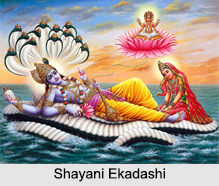 Shayani Ekadashi is the 11th lunar day (Ekadashi) of the bright fortnight (Shukla Paksha) of the Hindu month of Ashadha (June - July). This Ekadashi is known as "Sleeping Eleventh". Thus it is also known as "Ashadhi Ekadashi". This holy day is of special significance to Vaishnavas, followers of Hindu preserver Lord Vishnu. Shayani Ekadashi is also known as "Maha Ekadashi", "Padma Ekadashi", "Devshayani Ekadashi" or "Devpodhi Ekadashi".
Shayani Ekadashi is the 11th lunar day (Ekadashi) of the bright fortnight (Shukla Paksha) of the Hindu month of Ashadha (June - July). This Ekadashi is known as "Sleeping Eleventh". Thus it is also known as "Ashadhi Ekadashi". This holy day is of special significance to Vaishnavas, followers of Hindu preserver Lord Vishnu. Shayani Ekadashi is also known as "Maha Ekadashi", "Padma Ekadashi", "Devshayani Ekadashi" or "Devpodhi Ekadashi".
Legend of Shayani Ekadashi
It is believed that Lord Vishnu falls asleep in Kheer Sagar - cosmic ocean of milk - on Sesha Naga, the cosmic serpent. As per the Hindu legends, Lord Vishnu finally awakes, four months later, on the day of "Prabodhini Ekadashi". This slumber period of the lord is known as "Chaturmas" and it concurs with the rainy season. Thus, the day is also called "Dev-Shayani Ekadashi" or "Hari-Shayani Ekadashi" or "Shayani Ekadashi".
Worship of Shayani Ekadashi
On this day, images of Lord Vishnu and Goddess Lakshmi are worshipped. The entire night is spent singing prayers, and devotees keep fast and take vows on this day. It is to be observed during the entire "Chaturmas", the holy four month period of rainy season. These may include, giving up a food item or fasting on every Ekadashi day.
Fasting in Shayani Ekadashi
A fast is observed on Shayani Ekadashi to invoke Lord Vishnu"s blessings. The fast demands abstinence from all grains, beans, cereals, certain vegetables like onions and certain spices.
Scripture of Shayani Ekadashi
In the scripture "Bhavishyottara Purana", Lord Krishna narrates the implication of Shayani Ekadashi to Yudhisthir, as the Creator-God Brahma narrated the significance to his son Narada once. The story of King Mandata is narrated in this context. The pious king"s country had faced drought for three years, but the king was unable to find a solution to please the rain God. Finally, Sage Angira advised the king to observe the Vrata (vow) of Dev-Shayani Ekadashi. On doing so by the grace of Lord Vishnu, there was rain in the kingdom.
Yatra in Shayani Ekadashi
On this day, a huge Yatra or religious procession of pilgrims known as "Pandharpur Ashadhi Ekadashi Waari Yatra" culminates at Pandharpur, in Solapur district in south Maharashtra. Pandharpur is main centre of worship of the deity Vithoba, a local form of Lord Vishnu. The Yatra or the religious procession is a 17-day long grand event that attracts tourists to this place. Thousands of pilgrims come to Pandharpur on this day from different parts of Maharashtra. Some of them carry Palkis (palanquins) with the images of the saints of Maharashtra. These pilgrims are referred to as "Warkaris". They sing the hymns of Saint Tukaram and Saint Dnyaneshwar, dedicated to Vithoba.




















